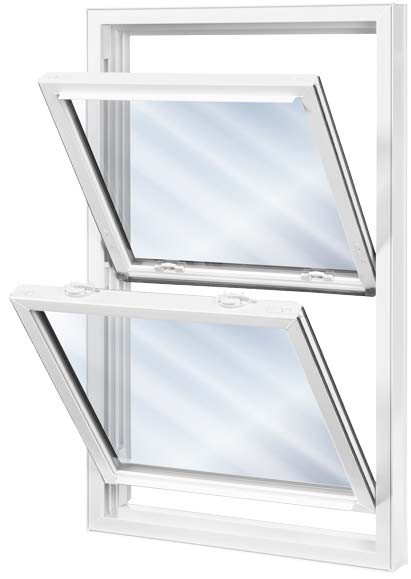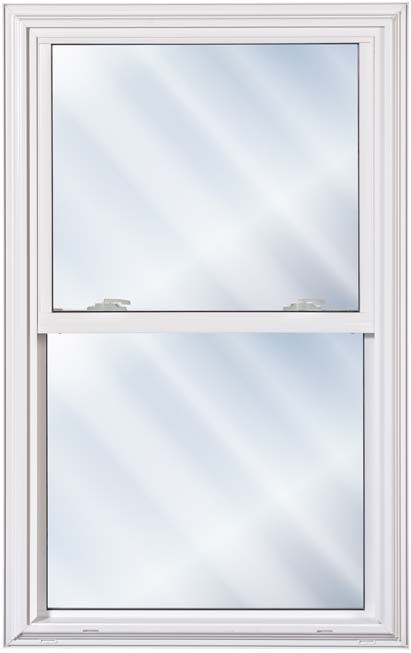The timeless beauty of single-hung and double-hung windows makes them the preferred style of window in homes across the United States. The simple design of single-hung windows and the versatility of double-hung windows makes these window types ideal for many homeowners.
Some people have a difficult time distinguishing the difference between these two windows, both in appearance and in functionality. Understanding single-hung vs double-hung windows can help you decide which kind is right for your home.
Here’s what every homeowner should know and what we will cover:
- What Are Single-Hung Windows?
- What Are Double-Hung Windows?
- What Does a Double-Hung Window Look Like?
- What Does a Single-Hung Window Look Like?
- How Do Single-Hung and Double-Hung Windows Work?
- Comparing Pros and Cons of Each Type of Window
- What Are Signs Windows Need To Be Replaced?
- How to Clean and Care For Windows?
What Are Single-Hung Windows?
Single-hung windows are usually taller than they are wide, with a fixed sash on top and a moveable sash on bottom. To open a single-hung window, the user lifts the bottom sash. At their most open position, single-hung windows can only be opened about half way (1).
What Are Double-Hung Windows?
Double-hung windows are taller than they are wide, and feature a moveable sash on top and bottom. To open a double-hung window, the user may lift the bottom sash or pull down the upper sash (2).
Double-hung windows are said to be more convenient to clean, because their sashes can tilt inward to make accessing the outside of the window easy.
What Does a Double-Hung Window Look Like?
To the untrained eye, it can be difficult to tell the difference between single and double-hung windows. In shape and character, they are very similar. Up close, the differences between these two windows are more obvious.
Double-hung windows have a thick casing to accommodate two tracks, one for each moving sash. This can make double-hung windows more clunky in appearance when compared to single-hung windows (3).

What Does a Single-Hung Window Look Like?
Single-hung windows have one track for a moveable sash. The upper sash, which is stationary, may mirror the shape of the lower sash, or may take on a different shape altogether. For example, upper sashes on single-hung windows may be arched or pointed.

How Do Single-Hung and Double-Hung Windows Work?
Double-hung windows consist of two moving parts: upper sash and lower sash. Each sash has its own track, which allows both sashes to move up and down without running into one another (4).
Homeowners who install double-hung windows are usually attracted to the versatility of these windows. With sashes that can move independent of one another, it's possible to open these windows from the top or the bottom.
Double-hung windows can also tilt inward for easy access to the exterior. This enables homeowners to clean double-hung windows without ever leaving the house.
Single-hung windows can only be opened from the bottom. Single-hung windows are the most classic form of residential window, because they were the type of window used in homes before double-hung windows had been invented (5).
For this reason, single-hung windows are typically used in older homes because they are more authentically historic.
Comparing Pros and Cons of Each Type of Window
Each type of window has its own advantages. Knowing the various benefits of each type of window can help you decide which type is right for you (6).
Single-Hung
Pros:
- Few air leaks. Single-hung windows fit more snugly in their frames and typically suffer from fewer air leaks.
- Unique shape. Because the upper sash of single-hung windows can't be moved in the track, the upper sash of a single-hung window can be different shapes, like arched or pointed.
- Popularity. Single-hung windows are the most popular and common type of window in residences in the United States.
- Lower price point than double-hung. Single-hung windows are less funtional, but their simplicity allows for a lower cost.
- More historically accurate. Single-hung windows are the window of choice for older homes, to retain authenticity.
Cons:
- Difficult to repair. The upper sash cannot be removed if it breaks. This means that a window glazier must be called to fix the glass in the upper sash of a single-hung window.
- Fewer ventilation options. With only one moving sash, homeowners have fewer options for ventilating their home.
- More difficult to clean. Cleaning a single-hung window from the outside can be a challenge, especially if the window is on the top floor of the home.
Double-Hung
Pros:
- Versatility. Both window sashes on a double-hung window can be moved up and down on their tracks. This gives homeowners more options regarding the way they ventilate their homes.
- Ease of use. Because sashes on double-hung windows are easily tilted inward or even removed, maintaining a double-hung window is easy. Even windows on the upper floors of a home can easily be tilted inward for cleaning. If the sash breaks, another one can be bought and inserted into its place.
- Safety. Parents of small children appreciate having the ability to open the upper sash for ventilation while leaving the lower sash closed.
Cons:
- Less energy efficient. Double-hung windows may lose their energy efficiency over time if both sashes and surrounding parts are not properly insulated.
- Added cost. Double-hung windows have more functionality than single-hung windows, so they often require an additional cost.
What Are Signs Windows Need To Be Replaced?
When a double-hung or single-hung window needs to be replaced, they'll display the same problems. Some common signs that a window is in need of replacement include (7):
- Rotten wood. Rotten wood around the window frame is a sign that the window needs major repair. You can tell if a window frame is rotten by poking the wood with a sharp object, like a screw driver or an awl. If too much of the wood is rotten, then the window should be replaced altogether.
- Rot around the sash. In a single-hung window, rot around the upper sash means that the window itself needs to be replaced, since the upper sash is a part of the window. In a double-hung window, replacing the sash should fix the problem.
How to Clean and Care For Windows?
The same materials can be used to clean both double-hung and single-hung windows. The process for cleaning may vary depending on the type of window.
To clean the glass of either type of window, use a combination of vinegar and water. Spray the glass with the mixture, then wipe it off with a squeegee. On a single-hung window, this is done first from inside the window, then from outside (8).
If the window is high off the ground, you'll need a ladder. On a double-hung window, all cleaning may happen from inside by tilting the sash inward, or by removing the sash altogether (9).
During monthly or quarterly cleaning routines, the sill, frame and sashes should also be inspected for signs of rot. Look for mold, discoloration, splintering and peeling paint. Poke the frame with the screwdriver or awl to check for rot.
If the frame and sash are made of painted wood, they will need to be repainted periodically. To do this, scrape away old paint with a scraper, then sand the wood until it is rough. Once this is done, a fresh coat of paint can be applied.
Keeping the wood painted can prevent wood rot, if the frames are made of wood. In vinyl, aluminum and fiberglass windows, this is less of a concern.
